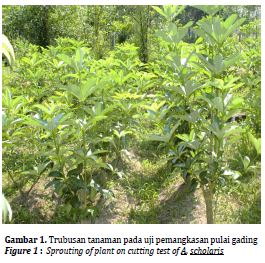The growth success of Alstonia scholaris (L.) R. Br. shoot cuttings from several shoots position and the cut type of cuttings

Downloads
Alstonia scholaris (L) R.Rr. is one of the fast growing species has a wide distribution in Indonesia and good prospect to be developed for forest plantation. This species could be propagated both generative and vegetative method. This study was conducted to identify the effect of shoot position and the cut type of cuttings. The experiment was arranged in Randomized Complete Design in two factors. The fisrt factor was shoot position (P1= < 50 cm, P2=50-100 cm, P3=100-150 cm and P4=150-180 cm above ground) and second was the cut type of cuttings (horizontal, diagonal 45o and “V” types). The result showed that shoot position significantly influenced rooting ability and the growth of cuttings. The best result of shoot cuttings was taken from P3 treatment (100-150 cm above ground) with survival percentage 87.50%, rooting percentage 85.42%, growth of height 4.02 cm, with 10 number of root, length of root 19.08 cm and 4 number of leaf . The cut type of cuttings and interaction between shoot position and type of cuttings were not significantly differences to the growth of shoot cuttings.
Adinugraha, H.A. (2011). Pengaruh Umur Pohon Induk, Umur Tunas dan Jenis Media Terhadap Pertumbuhan Stek Pucuk Sukun. Jurnal Pemuliaan Tanaman Hutan, 5(1), 23-30.
Akinyele, A.O. (2010). Effects of Growth Hormones, Rooting Media and Leaf Size on Juvenile Stem Cuttings of Buchholzia coriacea Engler. Annals of Forest Research, 53(2), 127-133.
Aini, A.S.N., V.S. Guanih and P. Ismail. (2010). Effect of Cuttings Position and Growth Regulators on Rooting Ability of Gonystylus bancanus. African Journal of Plant Science, 4(8), 290-295.
Aminah, H., J.M. Dick and J. Grace. (1997). Rooting of Shorea leprosula stem cuttings decreases with increasing leaf area. Forest Ecology and management, 91, 247 – 254.
Amissah, J.N. and N. Bassuk. (2007). Effect of Light and Cutting Age in Quercus bicolor, Q. Robur and Q. Macrocarpa Cuttings. Combined Proceeding International Plant Propagator’s Society 57, 286-292.
Anthony, M., J. James, C.S. Misra, L.D.M. Sagadevan, A.K.T. Veettil and V. Thankamani. (2012). Antimicobaterial Activity of the Plant Extract of Alstonis scholaris. International Academic Sciences Journal of Current Pharmaceutical Research, 4 (1), 40-42.
Elgimabi, M.E.N.E. (2008). Effect of Season of Cuttings and Humidity on Propagation of Ixora coccine. Advances in Biological Research, 2(5-6), 108-110.
Evans, J. (1992). Plantation Forestry in the Tropics. Oxford: Claderon Press.
Hartman, H.T., D.E. Kester, F.T. Davies and R.L. Geneve. (2002). Plant Propagation Principles and Practices. Sevent edition. New Jersey: Prentice Hall, Upper Saddle River. 880 pp.
Hendriyani, I.S. dan N. Setiari. (2009). Kandungan Klorofil dan Pertumbuhan Kacang Panjang (Vigna sinensis) pada Tingkat Penyediaan Air yang Berbeda. Jurnal Sains & Mat. 17(3), 145-150.
Hussain, A., M.K. Zman, and A.M. Ramteke. (2010). Antinmycobacterial Activity of Trunk Bark of Alstonia scholaris. Asian Journal of Phramaceutical and clinical Research, 3(4), 46-47.
Lyaruu, A.E., A.S. Nyomora and Z.L. Kanyaka. (2009). Evaluations of Provenances and Rooting Media for Rooting Ability of African Blackwood Stem Cuttings. Research Journal of Agricultural and Biological Sciences, 5 (4), 524-532.
Li, R., P. Guo, M. Baum, S. Grando, S. Ceccarelli. (2006). Evaluation of Chlorophyll Content and Fluorescence Parameters as Indicators of Drought Tolerance in Barley. Agricultural Sciences in China, 5(10), 751-757.
Mashudi. (2011). Pengaruh Asal Populasi dan Komposisi Media Terhadap Keberhasilan Stek Pucuk Pulai Darat (Alstonia angustiloba Miq.). Jurnal Pemuliaan Tanaman Hutan, 5(3), 159-168.
Nio, S.A. dan Y. Banyo. (2011). Konsentrasi Klorofil Daun Sebagai Indikator Kekurangan Air pada Tanaman. Jurnal Ilmiah Sains, 11(2), 166-173.
Pratap, B., G.S. Chakraborthy, and N. Mogha. (2013). Complete Aspect of Alstonia scholaris. International Journal of Pharmaceutical Research, 5(1), 17-26.
Sastrosupadi, A. (2013). Rancangan Percobaan Praktis Bidang Pertanian. Edisi Revisi. Yogyakarta: Kanisius.
Shah, M., A.M. Khattak dan M. Amin. (2006). Effect of Different Growing Media on the Rooting of Ficus binnedijkii (Amstel Queen) Cuttings. Journal of Agricultural and Biological Science. 1(3), 15 – 17.
Sharma, S.K. and S.K. Verma. (2011). Seasonal Influences on the Rooting Response of Pinus roxburghii. Annals of Forest research, 54(2), 241-247.
Soerianegara, I. dan R. H. M.J. Lemmens. (1994). Plant Resources of South East Asia 5, Timber Trees : Mayor Commercial Timbers. Bogor: Prosea.
Supriyanto dan K.E. Prakasa. (2011). Pengaruh Zat Pengatur Tumbuh Rootone-F Terhadap Pertumbuhan Stek Duabanga mollucana Blume. Jurnal Silvikultur Tropika, 3(1), 59-65.
Twokorski, T. and F. Takeda. (2007). Rooting Response of Shoot Cuttings from Tree Peach Growth Habits. (Short Communications). Scientia Horticulturae, 115, 98-100.
Winarni, E. (2009). Respon Pertumbuhan Stek Pulai (Alstonia scholaris (L). R. Br.) Terhadap Perbedaan Komposisi Media
Sapih Top Soil dan Cocopeat dengan Sistem KOFFCO. Jurnal Hutan Tropis, 10(25), 14-23.




